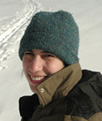 Dr. Emily Brodsky of the University of California, Santa Cruz, has been selected to be the first winner of the Charles F. Richter Early Career Award.
Dr. Emily Brodsky of the University of California, Santa Cruz, has been selected to be the first winner of the Charles F. Richter Early Career Award.
The Richter committee was impressed by the breadth and innovative aspects of Emily Brodsky’s research, which is broadly focused on elucidating “how earthquakes, volcanoes and landslides work.” She is cited for contributions to (1) earthquake triggering and distant effects of earthquakes, (2) rectified diffusion theory, and (3) fault lubrication theory (fluid pressurization). In her approach to these topics she has been taking full advantage of her strength in physics and fluid mechanics to understand the dynamic processes involved in these systems. For example, she has focused on understanding the nonlinear response of the crust to dynamic stress changes caused by the passage of seismic waves, to account for remotely triggered seismic, volcanic, and hydrologic activity. This is a very exciting and fruitful area, and she is already one of the dominant researchers in this field. She nicely complements theoretical work with data analysis and observational constraints. Only 5 years past her PhD at the time of her selection, she had published 13 papers, 6 as first author.
Emily Brodsky is unusually engaged in science. She takes on challenging projects, presents innovative and sometimes controversial hypotheses, and seeks debate in which she is eager to evaluate and consider any challenges to her initial ideas. Emily Brodsky is a worthy and exceptional young scientist who is a fitting first recipient of the Charles F. Richter Early Career Award.
